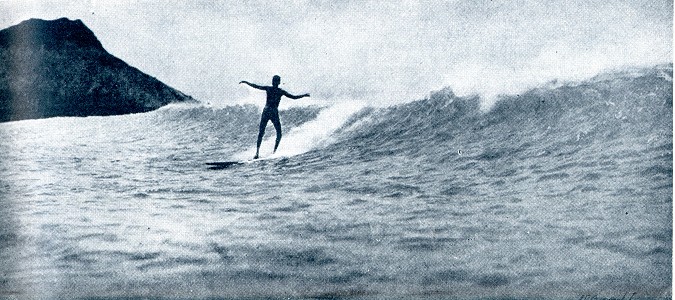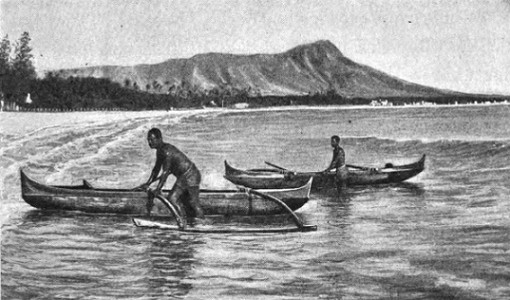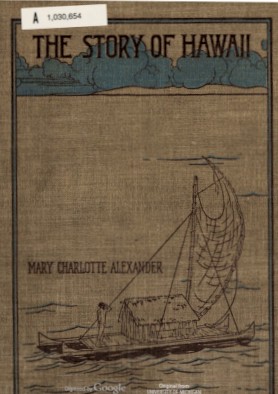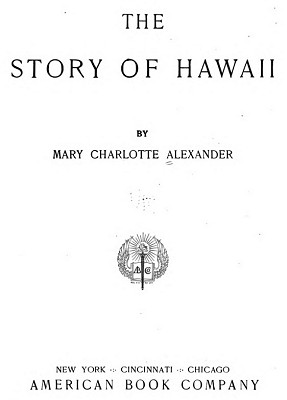
mary alexander : surf riding in hawaii, 1912
| home | catalogue | history | references | appendix |
 |
surfresearch.com.au
mary alexander : surf riding in hawaii, 1912 |
Hathi Trust
http://hdl.handle.net/2027/mdp.39015013448199

A Holua [reformatted]
"A chief, Kahawali,
the champion sled-rider on Kauai, hearing of a beautiful young woman at
Puna, who slid marvelous distances, brought his holua, or sled, from Kauai
to race with her.
On the day set
for the racing, people from far and near gathered on the hill where the
pili grass had been strewn over the smooth track for sliding.
In the crowd
stood the musicians with their drums of gourds, and the hula dancers, decked
Page 22
in maile and lehua,
wearing noisy anklets of dogs' teeth that rattled with every step.
Before the young
woman arrived, Kahawali and a friend brought out their long shining sleds
of dark kauila wood to practice.
They had made
them of two narrow, pointed runners, eighteen feet long, fastened together
two inches apart in front and wider behind.
"As Kahawali placed his sled a few yards back of the starting place, a wrinkled old hag, red-eyed and crooked-backed, limped up to him.
'"I wish to slide
too,' she whined.
'Lend me your
sled.'
Page 23
"' What does an
old woman like you want of a sled?' Kahawali answered in surprise.
'You are not
my wife that you should have my holua.'
"Out of pity, Kahawali's friend pushed his sled forward.
The old woman
and Kahawali grasped the sleds at about the middle with their right hands,
and running to the starting point, threw themselves with all their might
upon them, diving head-foremost down the steep hill, and gliding with lightning
speed over the plain below.
Kahawali slid
farthest and won the race.
Page 97

A SURF RIDER
[A. R. Gurrey Jr.]
For over two years
Kamehameha lived in Kohala, but not in idleness.
One of the first
chiefs to show the dignity of labor, he hollowed canoes with tools of bone
and shell, fished with mother-of-pearl hooks, and with an oo, a
sharpened stick, planted taro and cultivated his lands.
Some of his work
is shown to-day: several groves of noni trees
Page 98
at Halau that
Kamehameha planted before his beard was grown; a fish pond at Kiholo, a
canoe landing there; and a tunnel in a ridge at Niulii for a water course,
incomplete, because he had no powder to blast through the rock.
Kamehameha excelled
in his favorite sport of surf riding.
One day, when
he and his brother were scudding in front of the white breakers, he was
surprised to see his military teacher, Kekuhaupio, the veteran warrior,
approaching in a canoe.
Dripping, he
hurried to give him welcome at his house.
After the old
teacher had saluted Kamehameha with strange homage, he gently reproved
him for pursuing pleasure at such an unsettled time.
"You should be
bearing a hand in the affairs of Hawaii," Kekuhaupio chided.
Page 112
It was near the
close of November, the Hawaiian New Year was at hand.
The people dressed
their houses with new mats, and decorated them with green boughs.
Forty days before,
heralds had proclaimed the approach of the makahiki, or New Year's
festival.
This celebration
was held in honor of the kind god Lono.
The idol of Lono
would be dressed, and carried around the island while the taxes were being
collected.
Those who carried
the long idol would have their food put into their mouths, as their
hands would become
tabu in touching the idol.
It was a time
of games, of rest from all work, of peace and good will.
No hoarse conch
shells could scream for war.
The night before
the festival, bonfires glowed on the beach.
As the ocean
would be tabu four days, young and old lined the sand, pushing seaward
with their long light surf boards of wiliwili wood, swimming toward the
toppling white breakers.
At sight of Kamehameha,
who did feats in the ocean that no others dared attempt, well might they
chant from an old mele: —
"Here comes the
champion surf man,
While waves ridden
by surf riders beat the island,
A fringe of mountain-high
waves.
Glossy the skin
of the surf man;
Undrenched the
skin of the expert;
Wave-feathers
fan the surf rider."
| Page 113
People from other
districts had come to attend the festival.
Surf Board |
 |

Diamond Head
 |
The Story of Hawaii American Book Company, New York, c1912. Hathi Trust
|
 |

| home | catalogue | history | references | appendix |